
The high- versus low-risk approach
Oftentimes, patients who come in for treatment to Accelerated Care Chiropractic, PC have seen other specialists for acupuncture, massage, physical therapy, etc. in Midtown Manhattan for their condition. Maybe they’ve been sent to physical therapy for sports injuries, or have received cortisone injections to help manage knee or low back pain.
Whatever type of treatment patients seek, our staff asks them to consider it in simple terms: what is the risk, and what is the reward of this treatment?
Patients seeking care in our office are usually in acute pain, and they want to feel better as soon as possible. When you’re in pain, you’re likely to seek support from any specialist promising to get you feeling better fast.
Back pain slowing you down? Contact ACC today for relief that lasts!
But take a minute. Consider your options and all potential outcomes. After decades of working in pain management, Dr. Vlad seeks to break down why the simplest solutions are often more rewarding in the long run.
High-Risk, Moderate Reward
Consider surgery for back pain. A quick Google search reveals dozens of orthopedic surgeons around the Midtown Manhattan area. They offer cutting-edge technologies to treat various types of spinal problems and promise life-changing results.
Surgery can be considered a high-risk treatment option: it’s expensive, and, as Dr. Vlad explained, “you’re traumatizing the tissue. There’s going to be internal scar tissue in that part of the body now.” Down the line, scar tissue can minimize mobility in a region, and even cause adhesions that put pressure on nerves, leading to post-surgical pain and the term “failed back surgery syndrome.”
Once completed, surgery sets you back several weeks as you recover and pursue physical therapy. So, what is the payoff for surgery?
Unfortunately, not as high as many surgeons make it out to be. Of course this depends on many factors, like patient history and type of surgery.
Our office has treated plenty of patients looking to avoid going under the knife with alternate forms of pain management. There are also patients who had surgery, and are now seeking manual therapy because after a year or so of feeling great, that nagging pain that led them to surgery has returned.
There’s no “right answer” since everyone is different, but the patients who continue to report pain after surgery concern our team the most. In all likelihood, surgery was a bandage on a bigger issue, one that the surgeon never addressed.
“How do you go to someone who is trained to cut you and expect him to do anything else?” Dr. Vlad asks.
Low-Risk, High Reward
When they learn that our office is hesitant to advise surgery, patients often want to know: what other solutions are out there?
“Low risk is foam rolling, exercising, stretching, even treatments with me or a physical therapist or massage therapist,” Dr. Vlad says.
Taking ten minutes to stretch and foam roll each night, or setting reminders on your phone to remind you to hydrate may feel like baby steps compared to consulting a surgeon to deal with a herniated disc, and many patients are understandably concerned when they find that recovery won’t be as simple as getting adjusted and suddenly feeling “aligned” once again.
That makes a lot of sense: it’s scary to get X-rays and hear a doctor describe the deterioration in your spine. If surgery can “fix” a herniated disc in one go, is manual therapy really a comparable treatment option?
Here’s the thing: manual treatment takes time. It’s true that conditions can almost never be completely “fixed” in a single session, and it can be difficult for individuals to commit to the time and takes to come in once a week to truly heal. In New York City, time is a precious thing. Still, decades in the business have taught Dr. Vlad that his prescriptions for care do not disappoint.
“I always say this because it’s true: physiology is physiology,” says Dr. Vlad. “You go to the gym and understand that you have to train and then rest, train and then rest in order to see results. So why would it be any different with therapy? People seem to think that therapy is different from training, but muscle is muscle; it only works one way.”
So what makes the rewards of these low-risk behaviors so much greater? Those weeks that patients spend recovering, setting their timers for a few stretches, trying some light exercises to strengthen weakened muscles: it provides insight, Dr Vlad explains, “when it takes time, you have time to learn about yourself.”
Remember, those at-home treatments combined with the intense one-hour treatment you receive at our office is what makes for a winning combo.
Taking time to stretch is also less likely to interfere with even the most hectic work schedule. If you’re going under anesthesia for surgery, you’re going to have to ask someone else to pick the kids up from school. Many of the “tweaks” our office teaches patients to make, from exercises to ergonomic adjustments at the desk, can be performed while at work.
Curious about our treatment techniques? Here’s a breakdown of all the treatments offered at our office. Each one is catered to your specific conditions and preferences to optimize your recovery.
A patient complaining of neck pain might feel better after the first treatment with Accelerated Care Chiropractic, but she might notice after several weeks of following her stretching regime that her symptoms are worse after a long day working at a desk job. That leads to a discussion of desk setup, of ergonomic keyboards and office chairs. In other words, minute lifestyle changes.
“My answers are low-risk, high reward because I’m looking for answers that won’t hurt you and won’t have severe side effects,” Dr. Vlad explained. “I’m trained to look at the little things. A surgeon might be able to tell you about how he’s going to address your bulging disc, but that guy might not look at your desk job, or your lack of stretching or your diet. There’s different philosophies. I just like mine better.”
Ready to give low-risk, high-reward treatment a try? Contact our office to schedule your treatment!
